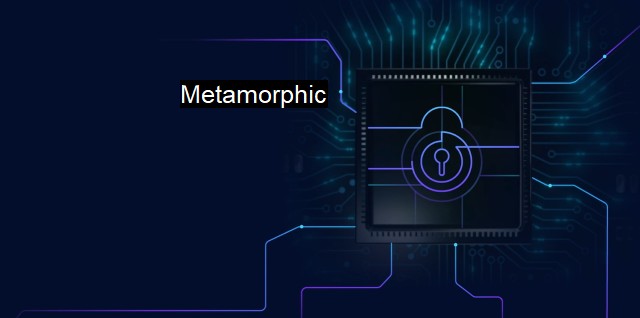What is Metamorphic?
The Threat of Metamorphic Malware: Understanding How Malware Evades Detection to Better Protect Computer Systems and Networks
Metamorphic viruses represent one of the most complex and sophisticated types of threats in the realm of cybersecurity and antivirus fields. Metamorphic malware can be quite a handful for antivirus software because of its unique and distinguishing feature: they constantly change code while keeping the primary purpose of disturbance, theft, and intrusion.In cybersecurity context, the metamorphic term pertains to the special ability of a virus to entirely re-write their codes in every new infection. This characteristic makes metamorphic viruses tough to detect since they never have the same structure twice. It gives the virus the ability to camouflage its signature, eluding traditional antivirus software that primarily operates based on virus signature detection. As such, these viruses present a significant and very complex challenge semantically and syntactically for the dedicated mind set behind any internet security system.
The fundamental goal of a metamorphic virus is to compromise system security and infiltrate a computer system undetected; it achieves this primarily by rewriting its underlying code. This ability to transform its code negates any form of pattern recognition employed by antivirus software, making metamorphic viruses robust against security defenses.
A metamorphic virus has various methods of rewriting its own code, avoiding detection via commonly used antivirus approaches. They use techniques like changing variable names, reordering independent instructions and reorganizing program blocks while preserving the original functionality of the malware and avoid patterns that antivirus detection could latch onto. Ones of the strongest metatmorphing techniques are register renaming and data/code integration, but the host of techniques available amplifies the challenge of tracking this kind of threat.
Even while introducing these changes in the entire code, a metamorphic virus mainly tries to ensure the preservation of the program's semantic integrity. So, although every single copy of the malicious software looks different once the virus remakes itself, a newly built metamorphic virus does not need additional resources or features for execution. This differing.Forms but semantically consistent approach to virus construction works with utmost proficiency to overpower every attempt of intrusion detection and fosters system exploitation.
Antivirus and cybersecurity organizations have had to devise advanced techniques for detecting and mitigating metamorphic viruses, going beyond paternity-based and simple heuristic techniques. They employ aggressive disassembly and assembly techniques - taking malicious code apart, analyzing behavior and then reassembling it - to identify unrecognized signatures in this constantly morphing code.
Building machine-learning (ML) algorithms with comprehensive knowledge about the malware helps in defending the networks. Machine learning algorithms leverage their ability to take a robust amount of data for training purposes and create a predictive model to forecast cyber attacks possibilities and malware infiltration by learning from past data. This can prove incredibly beneficial in tackling metamorphic viruses.
Metamorphic viruses present an intriguing and difficult challenge in the world of cybersecurity due to their adaptable and elusive traits. Their complex transformations based on advanced met morphing techniques amplify challenges for antivirus software and cybersecurity protocols. advancements in proactive antivirus mechanisms and extreme machine-learning capabilities offer promise in the battle against these ever-evolving threats.
The metamorphic malware's continual evolution and transformation make it an unidentifiable threat and a sophisticated weapon in the world of cybercrime. As such, the metamorphic virus is prompt evidence of the growing sophistication at the frontiers of cybercrime. Their ability to morph continually demands intensified efforts and sophisticated authentication protocols to curb their menace, hence pushing antivirus and cybersecurity research to endless new innovative fronts with every adaptive wave of the malware.

Metamorphic FAQs
What is a metamorphic virus in cybersecurity?
A metamorphic virus is a type of computer virus that is designed to change its code every time it infects a new file or system. This makes it challenging for antivirus software to detect and remove the virus since the code is constantly changing.How does a metamorphic virus work in a cybersecurity attack?
Metamorphic viruses work by altering their code to evade detection by antivirus software. They may also use encryption and other techniques to make it difficult for security software to analyze their behavior. Once the virus infects a system, it can steal data, corrupt files, or create backdoors for hackers to gain access to the system.What are some strategies for defending against a metamorphic virus?
To defend against a metamorphic virus, it is important to use up-to-date antivirus software that is capable of detecting and removing these types of viruses. In addition, implementing security best practices like maintaining robust firewalls, keeping software updated, and monitoring network activity can help to prevent attacks. User education and training can also be effective in preventing employees from inadvertently downloading and installing malicious software.What are some examples of metamorphic viruses in modern cybersecurity?
Some examples of metamorphic viruses in modern cybersecurity include W32.Metamorphic, which can change its code up to 700 times, and ZMist, which uses encryption to hide from antivirus software. There are also advanced persistent threat (APT) groups that use metamorphic techniques to evade detection, such as APT10, APT28, and APT32.| | A | | | B | | | C | | | D | | | E | | | F | | | G | | | H | | | I | | | J | | | K | | | L | | | M | |
| | N | | | O | | | P | | | Q | | | R | | | S | | | T | | | U | | | V | | | W | | | X | | | Y | | | Z | |
| | 1 | | | 2 | | | 3 | | | 4 | | | 7 | | | 8 | | |||||||